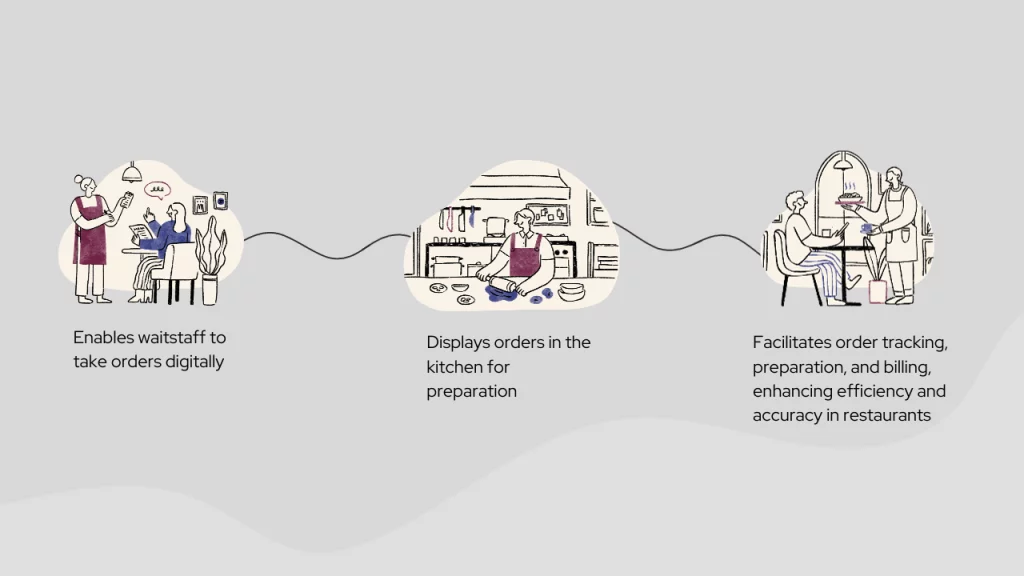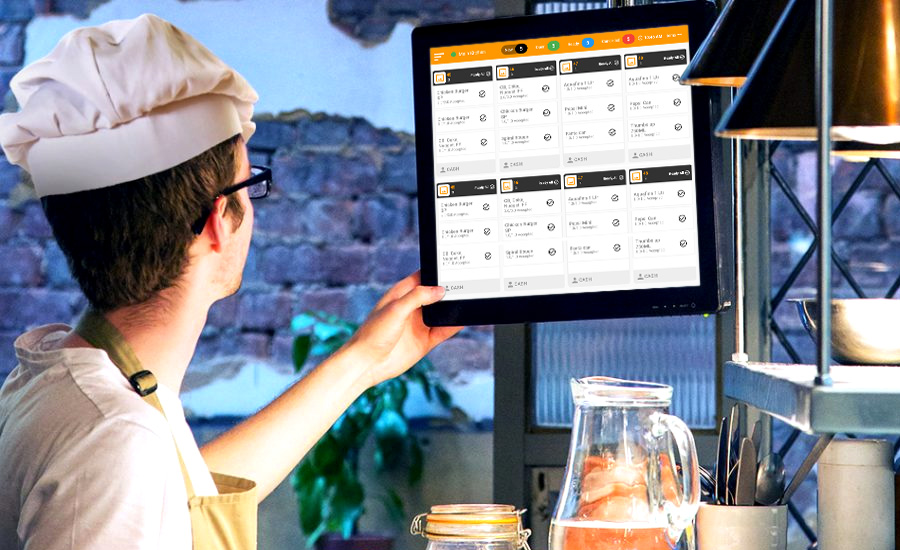The rise of technology has brought about amazing transformations in the restaurant industry. The quest for technologies to streamline the management system of a restaurant is now complete. The traditional practice of writing the names of dishes on small pieces of paper and handing them to the kitchen counter has become outdated. Instead, the advent of technology has revolutionized this process. Now, kitchen order tickets(KOT) are quickly generated and seamlessly transferred to kitchen display systems that are installed within the kitchen.
Implementing digital Kitchen Order Ticket (KOT) systems is proven to significantly reduce order errors. On average, restaurants that switch from manual handwritten orders to digital KOT systems report a substantial 60-80% reduction in order mistakes. In this blog, we will dive into everything you need to know about the kitchen order ticket.
What is KOT (kitchen order ticket)
A kitchen order ticket is a concise record of a customer’s order, generated through a point of sale (POS) system. When customers make an order online or give orders to the server, the order ticket will be transferred to POS and the kitchen. The ticket contains essential details such as the dishes, quantities, and other special instructions for the kitchen staff.
The kitchen staff can see the orders on the kitchen display screen(KDS). After preparing the dish as per the KOT prescription, the chef informs the servers to serve the food.
It helps you to keep strong communication and coordination between the front-of-house and back-of-house operations. and that leads to streamlining the order fulfillment process, enhancing efficiency, and facilitating accurate and timely preparation of meals.
How does digital KOT work?
Using digital KOT makes your restaurant operations simple and structured like this.

- Enables waitstaff to take orders digitally.
- Displays orders in the kitchen for preparation.
- Facilitates order tracking, preparation, and billing, enhancing efficiency and accuracy in restaurants.
Traditional method
The old KOT system was quite different from the new KOT system. It involved a lengthy process where order details were taken manually and written on paper. This method had several drawbacks compared to the new system, including the risk of paper tearing and a higher chance of human errors.
One of the main issues with the old KOT system is that each order ticket required three copies.
1. Takes orders and delivers tickets to the kitchen.
2. The cashier receives a second copy of the KOT to create a customer and restaurant copy of the bill for storing tickets for auditing and other record purposes.
3. The third is that the servers are waiting for tickets. The ticket will be torn after the quote details are given in detail to the main system.
Comparison between traditional KOT system and new KOT system
Let’s find the difference between the modern KOT system(digital KOT system) and the traditional KOT system(paper KOT system).
| Factor | New KOT System | Paper KOT system |
| Communication | Digital communication between front-of-house and kitchen | Manual communication through physical paper tickets |
| Order Accuracy | Reduced errors due to digital order entry and printing | Prone to errors due to manual writing and potential misplacement |
| Order Tracking | Real-time order tracking and status updates | Limited visibility into order status |
| Efficiency | Faster order transmission and processing | Limited visibility into the order status |
| Modifications and Updates | Easy to make modifications or update orders | Difficult to modify or update orders once written |
| Integration Seamlessly | integrates with POS systems and inventory | Limited integration capabilities |
| Reporting | Detailed order and performance analytics | Limited or no analytics capabilities |
| Training and Adaptation | May require staff training on new system | Familiar to staff due to longstanding use |
However, the table shows that digital KOT is much better and more efficient when compared to paper KOTs.
The main reasons why everyone stopped using paper KOT
Let’s examine why everybody is stopped using paper kitchen order tickets from restaurants.
Waste of time and doubles work
Managing with paper KOT takes a lot of time to process orders. It is very difficult for the servers to walk around punching every order into the kitchen. Also, it is very difficult for a chef because handwriting leads to misunderstandings and the chef needs to cross-check it. It wastes a lot of time.
Occurring errors
The servers are always busy. When the servers are busy taking orders from the customer and delivering it to the kitchen, there are so many chances for human errors. The chef will cook the dish as prescribed in KOT. It leads to inefficiency in orders and customer dissatisfaction.
Managing activities
No business can thrive without proper management. When it comes to restaurants, it can take a long time to deliver copies of the KOT 3 tickets we discussed earlier to authorized persons. Also, the paper order ticket does not include any information like who is cooking. So this will adversely affect the managing function of the restaurant.
Misunderstanding
Mistakes are human instinct. Not all papers the server writes need to be clean or the chef does not need to understand everything he writes in the paper KOT. There are a lot of possibilities out there for miss understanding.
It is also challenging for a cook to prepare an item based on assumptions. Therefore, the cook often needs to approach the server for clarification on each order.
Environment
Paper KOT negatively affects the environment. Daily usage of paper leads to excessive paper waste. Restaurants can aim to reduce paper use and take the initiative to protect the environment.
Benefits of digital KOT
Digital KOTs are fast and accurate. The system is structured to simplify and efficient fulfillment of order processing. Let’s look at the benefits of a KOT.
Save time
Saving time is one of the most important benefits. Digital KOTs speed up kitchen order processing, reducing preparation time by 20-30% for quicker customer service. Servers do not have to go to punch every order into the kitchen as before. You can place orders in the kitchen from anywhere in the restaurant. In addition, order time can be viewed on the system with the help of POS software and incoming orders can be prioritized.
Staff efficiency
The responsibilities of the staff are properly defined and the staff acts only according to their positions. The new KOT system has clearer communication between staff than ever before. Once the dishes are prepared in the kitchen, the waiters are notified and it is served to the customer very efficiently. Efficient separation of processes without confusion or repetition.
Reduces wastage
All orders will place in the server kitchen can be viewed in the KDS. This protects the food from overcooking and reduces wastage. The server records the orders on a POS handheld device instead of writing them on paper. It’s connected to the KDS system.
Sales and expenses
You can save 10-15% on operational costs by reducing food wastage and enhancing kitchen efficiency. These include the cost of purchasing paper for writing, kitchen order printing, and printed receipts. It all comes to an end with the advent of POS software.
It also helps in reducing the rising labor costs. You can manage your order-taking operations with a very limited number of employees.
Conclusion
Digital KOT simplifies one of the most important yet difficult-to-manage operations in a restaurant. Through this, an effective management system will be developed and a good team will be developed.

Investing in technology was a must to grow a successful restaurateur. You can automate many of your business operations with technology like self-ordering kiosks, and digital payment. While your competitor is using such technology in his business, you also need to try such ways to stay ahead in the restaurant industry. And it also helps you to give new experiences to your customers.
FAQ
What is KOT (kitchen order ticket)?
A kitchen order ticket is a concise record of a customer’s order, generated through a point of sale (POS) system. When customers make an order online or give orders to the server, the order ticket will be transferred to POS and the kitchen. The ticket contains essential details such as the dishes, quantities, and other special instructions for the kitchen staff.
How does KOT work in a restaurant?
Waiter taking orders from the customers or the customer placing orders online or at self-ordering kiosks. The orders pass (digital KOT) to POS and KDS(kitchen display screen). chef cooks the food as prescribed in the KOT. server delivering the food.
What are the benefits of using digital kitchen order tickets?
It helps you to improve order accuracy, faster order processing, and reduce communication and human errors, track and analyze order data. However, it enables a streamlined workflow.
Are digital kitchen order tickets cost-effective?
It helps to reduce errors, improve efficiency, and optimize workflows, it can lead to savings in labor costs, increased customer satisfaction, and potentially higher revenue.
Can digital kitchen order tickets help with order tracking and analytics?
Yes, it allows you to track orders, monitor preparation times, and provide detailed analytics and reports. That can be used to take data-oriented decisions.
Can digital kitchen order tickets integrate with other restaurant systems?
Yes, you can integrate it with various restaurant systems such as point of sale systems, kitchen display systems(KDS), and inventory management software. It facilitates seamless communication and helps to keep all of your business operations.
Visit Our Blogs Restaurant POS with online ordering, Software is changing the restaurant business, Everything you need to know about QSR POS, Need For Supermarket POS Software


11 replies on “Kitchen Order Ticket You Need To Know in 2023 and Beyond”
[…] – Get your orders to the kitchen in a flash with a KOT display or Station […]
[…] purpose of the KOT is to make the work of the employees much easier. Use the KOT display or station printers to deliver your orders to the kitchen in a flash and take orders and […]
[…] Kitchen Order Ticket You Need To Know in 2021 […]
[…] are technologies like online ordering, contactless payment, Kitchen display system, Waiter app, Kitchen order ticket, and KIOSK. When it comes to restaurant industry trends, POS software is at the forefront. Because […]
[…] kitchen. This is a huge process. It is also time-consuming. But the digital KOT is very different. KOT goes directly to the kitchen with the items, details, etc. ordered by the customer. The chef […]
[…] to Digital – Use Digital KOT and Receipts (minimize paper […]
[…] Errors in the conversation between the client and the server can sometimes be errors. or the server may have forgotten to write items on his paper KOT. […]
[…] software allows you to integrate with various restaurant functions and software such as kitchen order tickets (KOT), kitchen display system (KDS), Point of sale systems, accounting software, CRM, and loyalty […]
[…] platform. The restaurant management system can be connected with kitchen management systems such as kitchen order tickets (KOT), point of sale (POS), KDS (kitchen display system), and CDS (customer display), […]
[…] Kitchen Order Tickets You Need to Know by 2021 […]
[…] enables KOT printing for each order helping chefs and kitchen staff to promptly accept and prepare orders. This […]